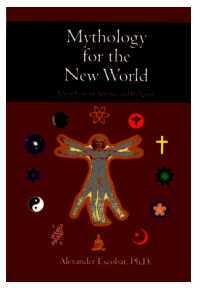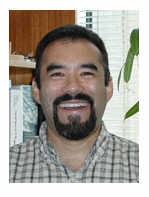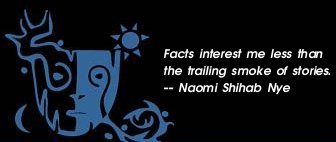|

Excerpts from Mythology for the New World
by Alexander Escobar, Ph.D.
Quoted with permission
Copyright 2005, 2007
Excerpt from Chapter 4, "Physical Realities", Pages 70 and 71:
So What's Out There?
 Although the science-based understanding of the universe discussed in this chapter seems unreal or non-intuitive, it is supported by a large amount of research. As you can imagine this research required a lot of checking and crosschecking since it goes against so much of what we take for granted. Although the science-based understanding of the universe discussed in this chapter seems unreal or non-intuitive, it is supported by a large amount of research. As you can imagine this research required a lot of checking and crosschecking since it goes against so much of what we take for granted.
The take home message of this chapter is that reality is very different than what we perceive it to be. All of the things we have in our daily lives are not solid in the way we tend to think of solid and can be more completely understood as patterns of pure energy. Indeed, the entire universe is filled with a diverse array of energy patterns and all of these energy patterns have specific properties associated with them. The periodic table is a set of universal energy patterns, each with its specific set of properties.
These patterns of energy exist in a space and time that is not fixed but varies with the observer. In fact, space and time can vary so much that some parts of our universe exist in a timeless and spaceless state. I will talk to you more about this in chapter eleven. From the descriptions in this chapter, it is clear to see that the universe is extremely complex. In chapter three, you learned that our perception of this complexity is limited, and as a result, our understanding of the universe is incomplete. Our everyday experience of the world is a slice — a single perspective of this complexity.
By cracking the certainty of your understanding, you have cracked the shell that held your awareness. This is the first step. Realizing that time, space and matter are not what we perceive them to be is the second step of our voyage. The third step is to realize that the psychic world created by our brains is the world in which we live. We humans live in a world of colors, sounds, tactile sensations, love, and much more that sits on top of the world of quarks, photons and electrons. Our psychic world is not separate from the physical world of energy patterns but is imbedded within and supported by it. The psychic world is real and has its own properties and parameters. One of the most meaningful of these is the spiritual experience, and we will turn to this in the next chapter.
Within science, we know the way we set up the experiment will determine the type of data we will acquire. In other words, the observer plays an important role in determining what is seen. In cases where different experiments give us different perspectives, we do not pick out one perspective and throw out the rest but instead juxtapose these perspectives and seek out a deeper truth.
 Figure 4.7 shows you two two-dimensional perspectives of a fish. See how different these two images are from each other? If you had no knowledge of the three-dimensional nature of fish, these views might be understood as completely different creatures. It is only by holding the various two-dimensional images together that we arrive at a more complete three-dimensional understanding of our fish. The universe is challenging us to do this with all of our interpretations. Philosophy, science, and religions all give us different perspectives of this same universe. By holding all of the interpretations from these different sources together, we can gain a more complete understanding of reality. Figure 4.7 shows you two two-dimensional perspectives of a fish. See how different these two images are from each other? If you had no knowledge of the three-dimensional nature of fish, these views might be understood as completely different creatures. It is only by holding the various two-dimensional images together that we arrive at a more complete three-dimensional understanding of our fish. The universe is challenging us to do this with all of our interpretations. Philosophy, science, and religions all give us different perspectives of this same universe. By holding all of the interpretations from these different sources together, we can gain a more complete understanding of reality.
Excerpt from Chapter 5, "World Religions", Pages 85, 86, 87:
Deep Truths
I have always been impressed by the work of linguists. By comparing various modern languages, it is actually possible to identify root words that were part of some original ancestor language. An example of this is Indo-European, which is believed to have been the predecessor to many current European and Indian sub-continent tongues. In the same way it is possible to tease out common threads of current languages and follow them to some deeper connection, it should also be possible to tease out commonalties from current world religions and find shared truths.
Despite their independent development and differences in religious practices, world religions attempt to access the deepest mysteries of all. Because they all delve into the same universe, it would make sense that, despite their superficial differences, they should still share some of the same concepts. Let us look at some of the common themes from religions around the world.
Unity
The beliefs of many religions indicate the universe is a continuous whole and that there is one force of which we are all a part or that is found in each and every one of us. In Hinduism, we have Brahman, which is the inner essence of all things. In the Abrahamic religions, we have the belief that God is infinite and omnipresent. In Taoism we find "the way" - the path along which all things reside and from which all things spring forth. The message is repeated over and over in sacred scriptures that we are not separate from this essence or greater awareness. We are intimately connected with the source of all things, and with each other.
Hidden Reality
There are many writings that indicate our consciousness is not aware of a greater or spiritual reality that coexists with our daily experience. Our senses or our forms of thought limit us. The Buddhists teach that suffering comes from a lack of knowledge of the true nature of reality. By clinging to the fixed forms around us, which have no basis in reality, we bring frustration into our lives. Hinduism calls it Maya - the great illusion or belief that the things we see around us are realities instead of products of the function of our mind and the way we categorize the world around us. Christianity speaks to us of the world of heaven - a place of peace and joy filled with the presence of God and a place of communion with God. Unlike many of the eastern traditions, the Abrahamic traditions (Judaism, Christianity and Islam) claim this hidden reality is only accessible after death.
Timelessness
The Ultimate is often described as being ageless or timeless. Consciousness exists on a different time scale. From the Tao Te Ching we have "Since before time and space were, the Tao is. It is beyond is and is not. How do I know this is true? I look inside myself and see." From the Upanishads, "The one who has seen that which is wordless, untouched, formless, unperishing, Without taste, ... , eternal, without scent, Beginningless, endless, higher than the great, constant, Is freed from the mouth of Death." In Psalms 90, the Bible states "For a thousand years in your sight are like a day that has just gone by, or like a watch in the night." The greater essence appears to exist within a different frame of time.
The Golden Rule
In various traditions we are asked to treat others as we would have them treat us. The great Hebrew teacher Hillel stated, "What is hateful to you, do not (do) to your neighbor: that is the whole Torah, while the rest is the commentary." In An-Nawawi's Forty Hadith (an important scripture of Islam) we find "None of you (truly) believes until he wishes for his brother what he wishes for himself." Jesus Christ is quoted as saying "love your fellow-man as yourself." These can all be taken as basic rules for the existence of society, although societies existed long before these words were written. On a deeper level, they may also indicate we are all one — kindred fellows of one family. From this perspective, it makes sense that we should all treat each other well since as we do to others, we also do to ourselves.
Afterlife
Although the concept of an afterlife is common to many religions, the manner in which it is thought to manifest itself differs. In the western traditions of Islam, Judaism and Christianity, the afterlife is considered to be a form of compensation for the life we lead on the physical plane. This afterlife is experienced by a conscious soul. The eastern traditions of Hinduism and Buddhism contain the concept of Samsara, which is the cycle of birth, death and rebirth. Life is viewed as an evolutionary process that continues life after life until one reaches a state of enlightenment. Whether in the West or East, however, there is the common belief that some nonphysical part of ourselves continues past this life.
What Does It Mean?
These traditions indicate reality is a wholeness. Although we experience reality as pieces and parts, we are asked to recognize this unity of which we all form a part and to treat each other with mutual respect. Since we are all part of the One, doing unto others is understood as doing to oneself.
There appear to be aspects of this greater reality we cannot access due to the limitations of our own consciousness. Although this greater reality coexists with our own, we are limited in our ability to perceive it, perhaps by our senses. The One is described as having a timeless quality, conceivably existing outside of what we think of as time. Also, death is not considered to be the endpoint of our existence but is believed to be a transition point either to another life or to the spiritual realm. There is some part of ourselves that continues on past physical existence.
We have studied other information from the fields of biology and physics. You know that science gives us information about our physical universe and is based on information we can receive through our senses or enhancements to our senses via instrumentation. How is it that spiritual leaders have come by their experience and knowledge? Their information does not seem to come from the senses, at least not the five common senses. Can we integrate the information we get from religions with that from science? Yes, we can!
Mythology for the New World by W. Alexander Escobar, Ph.D., may be ordered through booksellers or by contacting:
iUniverse
Lincoln, Nebraska
www.iuniverse.com
1-800-288-4677
 Alexander Escobar, Ph.D. is a Senior Lecturer in the Department of Biology at Emory University in Atlanta, Georgia. He received a Bachelor of Science degree in Genetics and a Doctoral degree in Biochemistry from the University of California. He has published scientific papers based on his research. His religious studies began as a young child while attending Catholic schools in his native San Francisco and have expanded throughout his adult life to include all the major religions of the world. It is Dr. Escobar's belief that religions and science offer descriptions of the same universe and that to truly understand the cosmos we must consider both. Alexander Escobar, Ph.D. is a Senior Lecturer in the Department of Biology at Emory University in Atlanta, Georgia. He received a Bachelor of Science degree in Genetics and a Doctoral degree in Biochemistry from the University of California. He has published scientific papers based on his research. His religious studies began as a young child while attending Catholic schools in his native San Francisco and have expanded throughout his adult life to include all the major religions of the world. It is Dr. Escobar's belief that religions and science offer descriptions of the same universe and that to truly understand the cosmos we must consider both.
 Mary Davis chairs Publications for the Mythic Imagination Institute. Davis was elected five times to the Atlanta City Council, serving there twenty years, she hopes making a difference for Atlanta's people. Consultant in public policy, strategic planning, public relations, marketing, writing, editing, and real estate; yoga teacher; actress; civic leader and activist; she says, "You name it, I have done most of it!" Davis especially enjoys her three adult daughters, six young grandchildren, and her friends, plus, of course, her involvement with the Mythic Imagination Institute, Emory University, and the Jung Society of Atlanta. Mary Davis chairs Publications for the Mythic Imagination Institute. Davis was elected five times to the Atlanta City Council, serving there twenty years, she hopes making a difference for Atlanta's people. Consultant in public policy, strategic planning, public relations, marketing, writing, editing, and real estate; yoga teacher; actress; civic leader and activist; she says, "You name it, I have done most of it!" Davis especially enjoys her three adult daughters, six young grandchildren, and her friends, plus, of course, her involvement with the Mythic Imagination Institute, Emory University, and the Jung Society of Atlanta.
Return to the Mythic Passages Menu
Subscribe to the Mythic Passages e-zine
|

